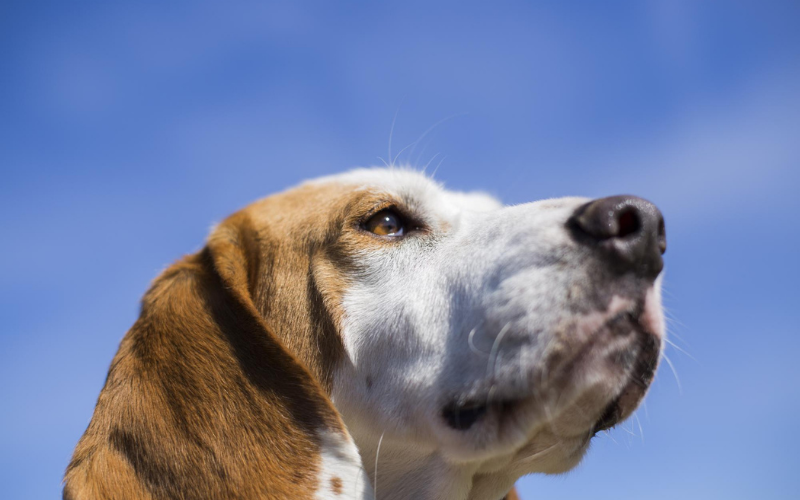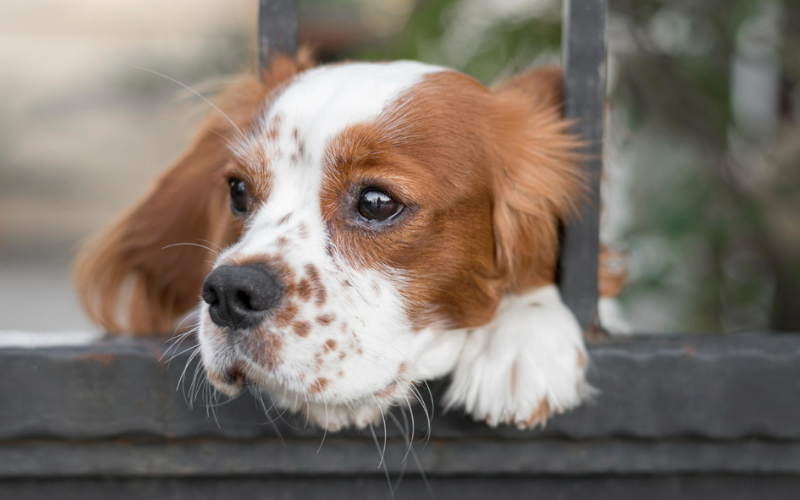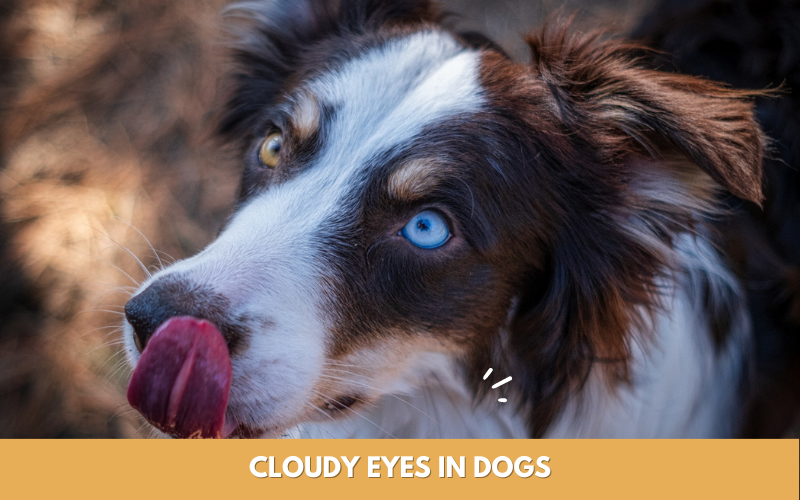Cloudy eyes in dogs is a common condition that affects many dogs at some point in their lives. This condition can be caused by a variety of factors, including cataracts, corneal dystrophy, glaucoma, progressive retinal atrophy, injuries, and infections. It is crucial for dog owners to be aware of the signs and symptoms of cloudy eyes in dogs and to seek veterinary care promptly if their pet is experiencing any changes in their eyes. In this article, we will explore everything of cloudy eyes in dogs. By gaining a better understanding of this condition, dog owners can help to ensure that their furry companions receive the best possible care and enjoy good eye health throughout their lives.
What do cloudy eyes in dogs look like?

Cloudy eyes in dogs can present in various ways depending on the underlying cause.
Some common symptoms include:
- Changes in eye appearance: Cloudy, hazy, or opaque eyes are a common symptom of dog’s cloudy eyes. In some cases, the pupils may also appear cloudy or have a bluish-gray tint.
- Changes in eye behavior: Dogs with cloudy eyes may exhibit changes in their eye behavior, such as increased blinking, rubbing their eyes, or pawing at their face.
- Changes in vision: Cloudy eyes can lead to changes in a dog’s vision. This may include difficulty seeing in low light, bumping into objects, or hesitancy in going up or down stairs.
- Discharge: Dogs with cloudy eyes may also experience discharge or excessive tearing from their eyes.
If you notice any of these symptoms in your dog, it is important to seek veterinary care promptly to determine the underlying cause and appropriate treatment.
What causes cloudy eyes in dogs?
There are several potential causes of cloudy eyes in dogs, including:
9 common causes
Nuclear sclerosis
This is a normal age-related change that occurs in the lenses of older dogs. The lenses become denser, leading to a bluish-gray haze in the eyes, but it does not usually affect vision.
Glaucoma
This is a condition where the pressure within the eye increases, leading to damage to the optic nerve and vision loss. The eye may appear cloudy, red, or swollen.
Ulcers
Corneal ulcers can lead to scarring or cloudiness in the cornea, the clear outer layer of the eye.
Cataracts
This is a condition where the lens of the eye becomes cloudy, leading to vision loss. Cataracts can be genetic, age-related, or secondary to other conditions such as aging, eye trauma, genetics, and cloudy eyes in dogs diabetes.
Dry eye
Also known as keratoconjunctivitis sicca, this condition occurs when the eyes do not produce enough tears to keep them lubricated, leading to inflammation and cloudiness.
Anterior uveitis
This is an inflammation of the eye’s uveal tract, which can cause the eye to become red, painful, and cloudy.
Corneal lipidosis
This is a condition where fats accumulate within the cornea, leading to cloudiness.
Corneal dystrophy
This is a genetic condition where the cornea becomes cloudy due to abnormal protein deposits.
Pannus
Also known as chronic superficial keratitis, this is an inflammatory condition that affects the cornea and can lead to cloudiness and vision loss.
It is important to note that each of these conditions requires prompt veterinary attention and treatment to prevent vision loss or further complications.
What causes dog’s red cloudy eyes?
Red cloudy eyes can be caused by several factors including glaucoma, corneal ulcers and other wounds, uveitis, corneal dystrophy, and dry eye. These conditions can cause redness, irritation, and cloudiness in the eyes of dogs. It is necessary for pet owners to seek veterinary care promptly if they notice any changes in their dog’s eye appearance or behavior.
What causes blue dog’s cloudy eyes?
There are several things that can make a dog’s eyes look blue and cloudy, such as nuclear sclerosis, cataracts, and corneal lipidosis. These conditions are usually not emergencies but require evaluation by a veterinarian as soon as possible.
What causes cloudy eyes in dogs with discharge
Dogs with cloudy eyes and discharge may have glaucoma, corneal ulcers and other wounds, uveitis, corneal dystrophy, dry eye, and pannus.These conditions can cause the eyes to get infected, swell up, or get hurt, which can cause cloudiness and discharge. It’s important to have a vet look at your dog’s eyes to figure out what’s wrong and the best way to treat it.
What causes cloudy eyes in dogs suddenly or overnight?
Cloudy eyes in dogs can occur suddenly or overnight due to a number of factors. Some common causes of sudden onset include trauma or injury to the eye, corneal ulcers, and infections such as bacterial or fungal keratitis.
In some cases, sudden onset of cloudy eyes can also be due to an acute attack of glaucoma, a condition where the pressure inside the eye increases, leading to optic nerve damage and loss of vision. If you notice sudden changes in your dog’s eyes, you should see a vet as soon as possible to find out what’s wrong and how to treat it.
How to diagnose cloudy eyes in dogs?

Diagnosing typically involves a combination of physical examination, eye examination, and diagnostic tests. The veterinarian will perform a thorough physical examination to assess the overall health of the dog and may perform an eye examination using specialized equipment to evaluate the structures of the eye.
Diagnostic tests may also be necessary to determine the underlying cause of the cloudy eyes. These may include:
- Schirmer tear test: Measures the amount of tears produced by the eye to evaluate for dry eye.
- Fluorescein stain: Helps detect corneal ulcers or scratches on the surface of the eye.
- Intraocular pressure measurement: Evaluates for glaucoma by measuring the pressure within the eye.
- Blood tests: May be performed to evaluate for underlying medical conditions such as diabetes or liver disease.
- Eye cultures: Can help detect bacterial or fungal infections.
Once the underlying cause of the cloudy eyes is identified, the veterinarian can develop an appropriate treatment plan to address the specific condition.
What to do if your dog has cloudy eyes?
If your dog has cloudy eyes, it is important to schedule an appointment with your veterinarian as soon as possible. The veterinarian will perform a thorough examination of your dog’s eyes and may recommend diagnostic tests to determine the underlying cause of the cloudy eyes. Cloudy eyes in dogs treatment options will vary depending on the cause of the cloudiness and may include medications, surgery, or lifestyle changes.
In the meantime, there are a few things you can do to help keep your dog comfortable:
- Avoid exposing your dog’s eyes to irritants such as smoke or dust.
- Keep your dog’s eyes clean and free of discharge by gently wiping them with a clean, damp cloth.
- Make sure your dog is on a healthy, balanced diet to support overall eye health.
- Keep your dog’s environment free of hazards that could cause eye injury.
Remember that early detection and treatment of cloudy eyes is important for the long-term health and well-being of your furry companion.
How do the vets treat cloudy eyes in dogs?
How a dog’s cloudy eyes are treated will depend on why they are cloudy in the first place. Here are some of the common treatments that a veterinarian may recommend:
Medications
Depending on the cause of the cloudy eyes, medications such as eye drops, ointments, or oral medications may be prescribed to reduce inflammation, treat infections, or manage underlying medical conditions.
Surgery
In some cases, surgical intervention may be necessary to treat the cause of the cloudy eyes. For example, cataract surgery may be recommended if the cloudy eyes are caused by cataracts.
Lifestyle changes
Making lifestyle changes, such as modifying your dog’s diet or reducing exposure to irritants, may be recommended in some cases to manage underlying medical conditions that can cause cloudy eyes.
Supportive care
In addition to treating the underlying cause, supportive care may also be necessary to keep your dog comfortable. This may include medications for pain relief or antibiotics to prevent secondary infections.
It is important to follow your veterinarian’s instructions closely and attend follow-up appointments to monitor your dog’s progress and adjust the treatment plan as needed. With proper treatment, many dogs with cloudy eyes can regain or maintain good eye health.
Home remedies for cloudy eyes in dogs
While there are some home remedies that may help manage symptoms associated with cloudy eyes in dogs. However, these remedies are not a substitute for veterinary care. It is always best to consult with your veterinarian before trying any home remedies. Here are some potential home remedies that may help manage symptoms associated with cloudy eyes:
- Chamomile tea: Applying a cooled chamomile tea bag to your dog’s eyes may help soothe irritation and inflammation.
- Saline solution: A homemade saline solution made with distilled water and salt can help flush debris from the eyes and reduce discharge.
- Coconut oil: Applying a small amount of coconut oil around the eyes may help moisturize and soothe the area.
- Supplements: Certain supplements, such as omega-3 fatty acids or antioxidants, may help support overall eye health.
Again, it is important to consult with your veterinarian before trying any home remedies. Some home remedies may be inappropriate or even harmful for certain dogs, depending on the underlying cause of the cloudy eyes.
How to prevent cloudy eyes from my dog?

While there is no guaranteed way to prevent cloudy eyes from dogs, there are some steps that you can take to help reduce the risk of developing this condition. Here are some tips to help prevent cloudy eyes in dogs:
- Regular veterinary check-ups: Schedule regular veterinary check-ups for your dog, including routine eye exams, to detect any potential problems early on.
- Proper nutrition: Provide your dog with a balanced and nutritious diet to help support their overall health, including their eye health.
- Protect the eyes: Protect your dog’s eyes from injury by using protective eyewear when engaging in activities that could cause harm to the eyes, such as playing fetch or swimming.
- Keep the eyes clean: Keep your dog’s eyes clean and free of discharge by wiping them gently with a damp cloth and avoiding exposure to irritants such as smoke or dust.
- Manage underlying medical conditions: Manage any underlying medical conditions that could potentially lead to cloudy eyes, such as diabetes or high blood pressure, by working closely with your veterinarian to develop an appropriate treatment plan.
Remember, regular veterinary care and a healthy lifestyle can help keep your furry companion’s eyes healthy and reduce the risk of developing cloudy eyes.
FAQs
Can dogs with cloudy eyes still see?
Yes, dogs with cloudy eyes can still see but the degree of vision may be affected depending on the severity and underlying cause of the cloudiness.
How long does it take for cloudy eyes in dogs to clear up?
The duration depends on the underlying cause. In some cases, it may clear up with treatment while in other cases, it may be a chronic condition that requires ongoing management.
Can certain dog breeds be more prone to cloudy eyes?
Yes, certain dog breeds can be more prone to developing cloudy eyes. For example, breeds like the Siberian Husky, Samoyed, and Alaskan Malamute may be more prone to developing cataracts.
Is it safe to use human eye drops on dogs with cloudy eyes?
No, it is not safe to use human eye drops on dogs with cloudy eyes. The ingredients in human eye drops may be harmful to dogs and can cause adverse reactions.
Are cloudy eyes in dogs more common in older dogs?
Cloudy eyes in dogs can occur at any age, but it is more common in older dogs. As dogs age, they may develop cataracts or other age-related conditions that can cause cloudiness in the eyes.
Conclusion
In conclusion, cloudy eyes in dogs can be caused by a variety of factors, and it is important to seek veterinary care promptly if you notice any changes in your dog’s eyes. If your dog does develop cloudy eyes, your veterinarian can help determine the underlying cause and develop an appropriate treatment plan to help manage the condition. By staying vigilant and working closely with your veterinarian, you can help ensure good eye health and overall well-being for your furry companion. Remember, early detection and treatment of cloudy eyes in dogs is essential to ensuring a happy and healthy life for your beloved pet.

